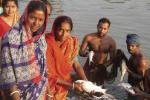
Bangladesh: fish ponds. Photo: Bread for the World, USAID
Rigorous studies on the effects of introduced fish pond and vegetable technologies in Bangladesh show that “..women’s assets increase more relative to men’s when technologies are disseminated through women’s groups”, indicating that the gendered outcomes of new technologies depend on how they are introduced. This and related studies are reported in papers in the latest edition of the Journal of Development Effectiveness (http://www.informaworld.com/smpp/title~db=all~content=g938482929) and in a publication of the International Food Policy Research Institute.
Author’s (Agnes Quisumbing, IFPRI) address: a.quisumbing@cgiar.org
Photo: http://www.flickr.com/photos/breadfortheworld/3963781730/
This is an overview of research on the impact of “three antipoverty interventions in Bangladesh—the introduction of new agricultural technologies, educational transfers, and microfinance—on monetary and nonmonetary measures of well-being. This paper begins by setting out the conceptual framework, methodology, and empirical methods used for the evaluation of long-term impacts. It discusses the context of the evaluations and the longitudinal data used. Key findings from the individual papers are then presented, followed by an indicative analysis of the cost-effectiveness of these interventions. The overview concludes with implications for programs and policy.”
Authors: Quisumbing, Agnes R., Baulch, Bob, Kumar, Neha
Download at: http://dx.doi.org/10.1080/19439342.2011.570447 or
http://www.ifpri.org/sites/default/files/publications/ifpridp01077.pdf
This entry was posted in: Bangladesh, Gender, Men, Women
